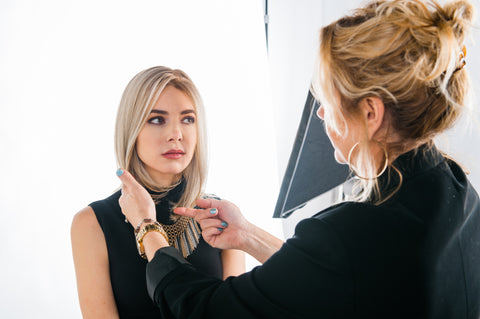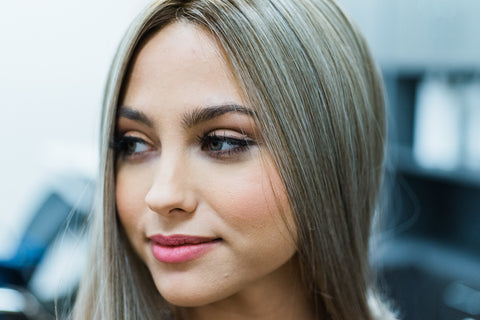7 Tips to Making Your Wigs Look More Natural
Wigs have become incredibly popular as a way to switch up your look or to feel more confident when going through hair loss. We understand it’s important to you that no matter the occasion for wearing your wig, you want it to look as natural as possible. The good news is that there are plenty of ways to make your wigs look more natural. Here are seven tips to help you do just that.

1. Choose The Right Wig Colour For You
Choosing the right colour is one of the most important aspects of making your wig look natural. You want to choose a colour close to your natural hair colour or complement your skin tone. If you're not sure which colour to choose, we would love to show you around our First Lady Showroom and explore all of the different colours in your favourite styles
You can make your appointment to visit the First Lady Showroom by calling 1-844-367-9447 EXT. 313 (Canadian appointments only, please)
If you're trying to match your natural hair colour, take a picture of your hair to help you find the right shade. Do your best to take the picture in direct sunlight to capture the true shade and undertones. Keep in mind that natural hair often has different shades and highlights, so a wig that has a few different tones can look more natural than one that is a solid colour.
If you want to try a different colour than your natural hair, consider choosing a colour that complements your skin tone. Cool skin tones look best with cooler hair colours like ash blonde or black, while warm skin tones look best with warmer hair colours like golden blonde or auburn.
2. Consider the Wig's Style and Length
The style and length of your wig can also make a big difference in how natural it looks. If you have short hair, consider a wig with a similar length. If you have long hair, look for a wig with layers or movement that matches your natural hair. It's also important to choose a style that complements your face shape.
For example, if you have a round face, a wig with the volume on top and sleeker sides can help to elongate your face.
A wig with bangs can help balance your forehead and jawline if you have a heart-shaped face.
It's important to try on different styles and lengths to see what works best for you. Don't be afraid to experiment and try something new!
3. Find The Right Wig Cap Construction
There are several types of wig cap constructions available on the market. Each one offers different benefits, and the best option for you will depend on your individual needs and preferences. Here's a breakdown of the most common wig cap constructions:
Machine Made
The traditional cap is the most common type of wig cap construction. It features a closed lace cap at the top, which is typically made of a material like a monofilament or silk that allows for a natural-looking part. The rest of the cap is made from machine-sewn wefts of hair attached to an elasticized base.
Pros: Traditional caps are widely available and typically less expensive than other cap types. They also offer a natural-looking part, which can be important for those with hair loss or thinning.
Cons: Traditional caps can be hot and uncomfortable to wear for long periods of time, particularly in warm weather. They also don't offer much ventilation, which can make them feel heavy on the head.
Lace Front Cap
The lace front cap features a thin strip of lace at the front of the wig, which is hand-tied to create a natural-looking hairline. The rest of the cap is typically made from machine-sewn wefts of hair attached to an elasticized base.
Pros: Lace front caps offer a very natural-looking hairline, which can be important for those with hair loss or thinning. They are also more comfortable to wear than traditional caps, as they offer better ventilation.
Cons: Lace front caps can be more expensive than traditional caps. They also require more maintenance, as the delicate lace at the front of the cap can easily become damaged.
Monofilament Cap
The monofilament cap features a thin, transparent material at the top of the wig that allows for a natural-looking part. The rest of the cap is typically made from machine-sewn wefts of hair attached to an elasticized base.
Pros: Monofilament caps offer a very natural-looking part and can be more comfortable to wear than traditional caps, as they offer better ventilation.
Cons: Monofilament caps can be more expensive than traditional caps. They also require more maintenance, as the delicate material at the top of the cap can easily become damaged.
4. Use a Wig Cap
Wearing a wig cap can help keep your wig in place and create a more natural look. A wig cap will also help to conceal any natural hair that may be peeking through the wig. Choose a wig cap that is close to your skin tone for the most natural look.
Different types of wig caps are available, including nylon caps, mesh caps, and bamboo caps.
Nylon caps are the most common and affordable option, but they can be hot and uncomfortable, especially in the summer months. If this is the best option for you, click here for a Nylon Wig Cap from First Lady Products
Mesh caps are more breathable and comfortable compared to nylon wig caps. They prevent slipping and help your wigs fit better. If this is the most desirable option for you, click here to try First Lady Product’s Mesh Wig Cap
Another option that is the most expensive but provides a great amount of comfort and breathability is Bamboo wig caps.
5. Use the Right Products
Using the right products on your wig can also help it look more natural. Avoid using products that are too heavy or greasy, as this can weigh down the wig and make it look unnatural. Instead, opt for lightweight products that are specifically designed for wigs.
Some products to consider include wig spray, wig shampoo and conditioner, and wig styling products like hair gel or wax. When using styling products, make sure to apply them sparingly and work them into the wig fibres gently to avoid tangling or damaging the wig.
First Lady Products has a variety of different wig-friendly products that are all cruelty-free and environmentally friendly. Click here to see their wide selection
6. Makeup In The Part
If you’re wearing a monofilament and/or lace front wig, you want to ensure the part matches and blends with your natural skin tone.
Take a small amount of your regular foundation on a small brush and gently go over the part. This will create a seamless blend and help your wig look even more natural!
If you’re looking for a machine-made wig, you will not need to complete this step, as the part is covered by the hair.
7. Practice, Practice, Practice
Finally, the key to making your wig look more natural is practice. The more you wear your wig and experiment with different styles and techniques, the more comfortable and confident you will become.
Don't be afraid to make mistakes or try something new. With a little bit of patience and practice, you'll be able to make your wig look so natural that no one will be able to tell you're wearing one!

Conclusion
Wearing a wig can be a great way to change up your look or cover up hair loss, and we know it's important to you to make sure your wig looks as natural as possible.
By choosing the right colour and style, using a wig cap, finding the right cap construction, using the right products, taking care of your natural hair, and practicing, you can make your wig look so natural that no one will be able to tell you're wearing one.
With these seven tips, you can confidently wear your wig and feel great about how you look!


